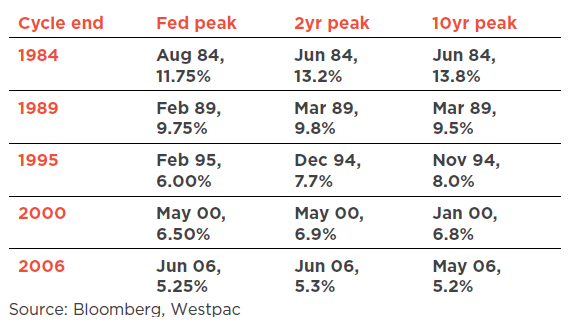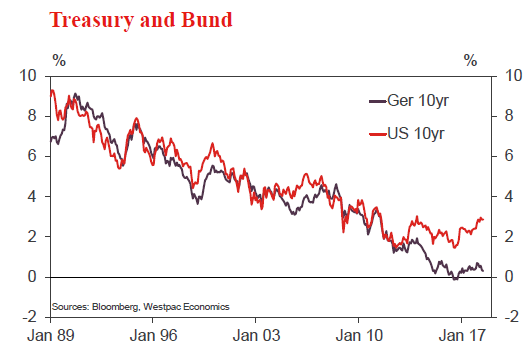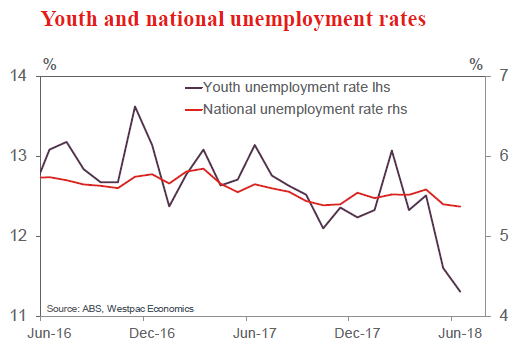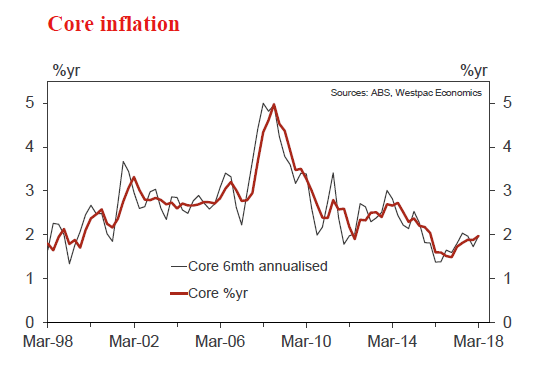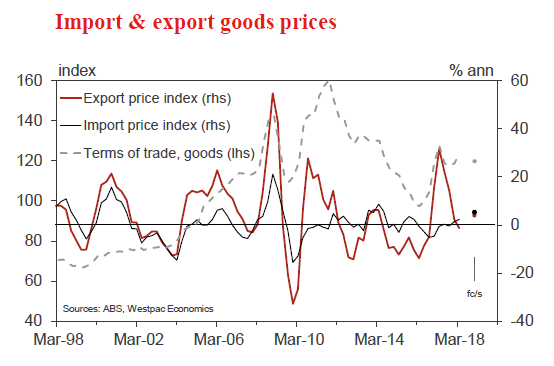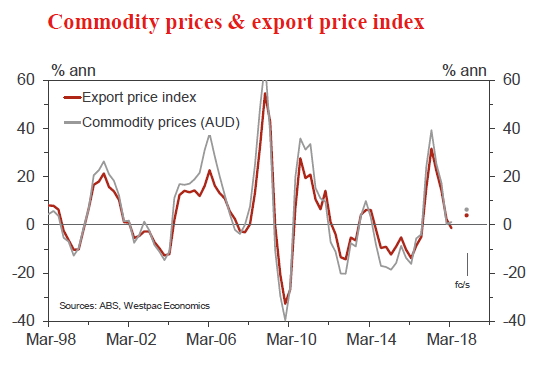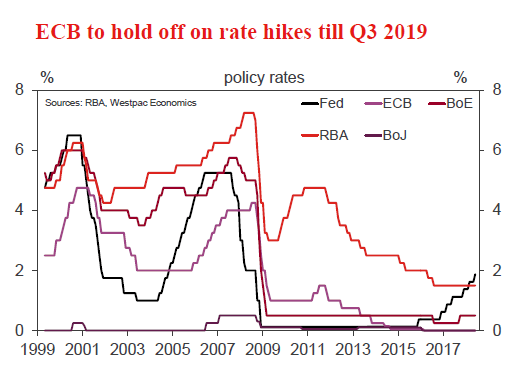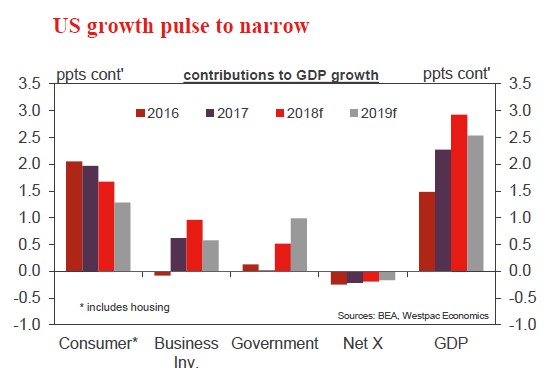Week beginning 23 July 2018
- Our RBA forecast remains on track; FED no longer likely to pause in December.
- Australia: CPI, PPI, trade prices.
- NZ: trade balance.
- China: industrial profits.
- Europe: ECB policy decision, credit data.
- US: GDP, durable goods orders.
- Flash PMIs for Japan, Europe and the US.
- Key economic & financial forecasts.
Information contained in this report current as at 20 July 2018.
Our RBA Forecast Remains on Track; FED No Lnger Likely to Pause in December
Markets are now broadly pricing in Westpac’s view on the outlook for the RBA cash rate with only around a 50% chance of a rate hike by the end of 2019. That is in stark contrast to a year ago when our call that rates would remain on hold in 2018 and 2019 was well out of market with markets anticipating around 75 basis points of tightening by the end of 2019.
A weakening housing market; soft inflation and wages growth; an uncertain consumer and pressures on funding have all conspired to cool markets’ expectations. That key dynamic around an uncertain consumer facing constraints on income growth with a falling savings rate always stood out as a key constraint on the ability of the household sector to lift spending in the way anticipated by the markets.
While markets have moved largely to embrace our view, the Reserve Bank still expects to be raising rates over the course of 2018 and 2019. I think that is apparent in their ongoing above trend growth forecasts for 2018 and 2019. But, as we have argued before, the Bank does not have a perfect track record with its forecasts (as none of us in the economics community do) and it will react to any differences between its forecasts and “reality” in a timely fashion.
On the other hand our forecasts for the US Federal Funds rate have been consistently above market expectations. Our analysis of the current market pricing is for around 65 basis points of further tightening through 2018 and 2019. We have expected a total of 75 basis points over that period with one 25 bps hike in September, followed by a pause, and then 25 bps hikes in March and June with the rate peaking at 2.625% in mid – 2019.
We have expected that signs of the US economy slowing into the second half of 2019 (partly under the weight of a sharp slowdown in government spending) would see the FED curtailing its tightening cycle in anticipation of eventually cutting rates from 2021.
Under that scenario we had been arguing for a weakening AUD/ USD which had subsequently peaked around 0.81 in late January this year.
Under our relative rate profile the AUD/USD cash rate differential would sink to an unprecedented – 112.5 basis points by June 2019 (previous mark in the post stagflation history was – 50 basis points in the late 1990s).
That was likely to take a heavy toll on the AUD/USD with our target being 0.72 by next June.
That sum of 75 basis points of hikes from the FED was still slightly above market expectations but we now believe we need to be even more bold on the FED forecasts.
Trends in core inflation; wages; and employment are increasingly casting doubt on a FED pause between September and March.
On a six month annualised basis, the core PCE is now running at 2.3% (to May) and the Employment Cost Index is rising at 2.9% (to March). This pace is somewhat faster than we had expected providing the FED with ample justification for not pausing. In that regard we note that the FED has emphasised the symmetrical nature of its inflation objective and therefore not indicating any immediate concern that the momentum in the core PCE is running above the 2% target. As such, we are still expecting the gradual (3 month intervals) approach to the tightening cycle.
We now expect the FED to continue to edge rates up with an additional December hike of 25 bps while maintaining the June 2019 target timing for the end of the cycle.
That would indicate a peak Federal Funds rate of 2.875% by June 2019 – still short of the peak in the “dots” (the median of FOMC members’ estimates) of 3.4% by end 2020 and 3.1% by end 2019.
Given our RBA outlook this revised forecast sees the spread between the RBA cash rate and the Federal funds rate reaching minus 137.5 basis points by June next year.
Markets are currently pricing in a margin of around minus 100 basis points so there is still ample scope for the AUD/USD to weaken further and the long bond spread to widen to our mid 2019 targets of USD 0.72 and negative 40 bps respectively (currently USD 0.735 and minus 20 bps).
Note that back in October last year when we were strongly promoting the prospect of a sharply negative differential between the RBA cash rate and the fed funds rate, the AUD was trading around USD 0.79 and the Australian 10 year bond rate was 50 basis points higher than the US 10 year bond rate.
Since October last year the US 10 year bond rate has lifted from 2.32% to 2.82%. However, more recently, the rate has actually fallen from its peak in May of 3.1% despite stronger momentum in the US economy and more associated confidence around the FED’s commitment to rate hikes. (2 year bond yields have lifted by around 10 basis points over that period.)
There are numerous explanations for the fall in the 10 year rate:
- Global growth concerns associated with a “trade war”.
- Recognition that previous rate hike cycles have been marked by the 10 year bond rate peaking at about the same level as the fed funds rate.
- Current record spread to German Bunds of around 250bps.
Consider the table below:
On the other hand, there are also respectable arguments for higher US bond rates:
- While the trade war discussion focuses entirely on the implications for investment in US exporting industries, issues around the impact of tariffs on inflation and investment by import competing industries seem to be ignored.
- Assumptions are almost entirely biased towards a negative outcome from the trade discussions. There remains the possibility of some lowering of trade barriers in response to Trump’s tactics.
- The supply/demand dynamics of the US bond market are also conducive to higher rates with supply being lifted by new Treasury issuance (recent issuance plans being focussed on a wide distribution across the yield curve) and demand being affected by the reversal of QE by the FED and some potential political resistance to purchasing Treasuries due to the trade tensions.
- In considering previous tightening cycles we have never seen a cycle where the bond rate has peaked more than 12 months before the end of the FED’s tightening cycle (see table). It may be that the guidance provided by the FED has encouraged bond markets to pre – empt the moves in the Federal funds rate.
- As discussed, we expect that markets are underestimating the likely extent of the FED’s tightening cycle.
- The FED is unlikely to be dissuaded from tightening with a view on the yield curve. While 9 of the last 10 inverse yield curves (10’s versus cash) have correctly signalled recession, they have been characterised by a FED which has over – tightened due to losing control of inflation late in the cycle. We expect this will not be the case in this cycle with the FED being able to go on hold at around 30 bps above neutral (assessed as around 50 bps in real terms). To the extent that US bond rates are held down because of relative interest rates rather than some concern about US growth, it distorts the “recession” signal which may be contained in the shape of the yield curve.
- The ECB is set to end QE by end December while the BOJ has been tapering its bond purchases.
Our current US 10 year forecast envisages the rate eventually peaking around 3.5% in the June quarter 2019 prior to the FED going on hold. Recognition by the market that the FED was likely to go on hold (but not really becoming a clear signal until well into the September quarter) would then see a solid retracement in the bond rate through the course of the remainder of 2019 and 2020. That peak in the 10 year bond rate would be 60 bps above the eventual Fed funds peak, (and is therefore unusual), albeit around the current peak level of the “dots”. We do not envisage any major downward assessment of the dots over the course of the next 12 months.
The outlook for the US 10 year bond rate is the most intriguing challenge facing markets. We have set out some strong arguments supporting our current view that there will be another up leg in the cycle through to mid – 2019. We recognise there are respectable arguments opposing that view and would certainly grant that the risks around the 3.5% cycle peak are more to the downside than the upside.
The week that was
This week has been full of contrasts. For Australia, our Leading Index fell below trend as employment growth jumped higher. In China, GDP met the market’s robust expectation for Q2 as the latest credit data clouded the outlook. And in the US, Chair Powell put forward a positive view on the outlook, while remaining cognisant of the risks.
Beginning with Australia, in June the Westpac – MI leading index recorded its first below – trend reading since September last year. Notably, this deceleration came about owing to domestic factors: a turnaround in unemployment expectations, a deepening contraction in dwelling approvals and a reduction in support from Australian dollar denominated commodity prices. This week’s June employment outcome was well ahead of this level (51k jobs created; 41k of which were full time); but over 2018 to date, the average has been 19k. Comparing the first half of 2018’s 19k average to the 34k month – average of 2017 highlights why households are (a little) less confident in their employment prospects. However, as these gains are enough to hold the unemployment rate steady, one suspects that sentiment in this area of the economy will remain robust. See chart of the week below.
More broadly on the RBA, the July meeting minutes clearly highlighted the many tensions regarding growth for policy at the moment. Continued job gains; public infrastructure and non – residential construction combined should offer the economy strong support through 2018 and 2019, yet the debt burden of Australian households and persistent weakness in wage growth cast a long shadow. Some had hoped for guidance from the RBA on short – term funding pressures and the potential impact it could have on activity. Detail however was scant, with the RBA instead keen to continue investigating the issue.
Of equal significance with activity growth for policy is inflation. Next week’s June CPI is expected to be (yet another) benign print, at 0.4 (2.1%yr) for headline inflation and 0.5% (1.9%yr) for core. Our preview has all the component detail for those interested, but two additional points are worth noting here. First is that for the past 18 months, market forecasters have consistently overestimated inflation outturns. Second, recognising the persistence of this disappointment as well as the disinflationary impact of energy prices over the year ahead, we have recently revised down our view for inflation in 2018 and 2019. We now believe it will be difficult for the CPI to move materially above the bottom of the RBA’s target range over that entire period.
Turning then to the global economy, China was front and centre this week. GDP came in right on the market’s expectation of 6.7%yr. The detail was consistent with the intent of authorities: for improved consumer incomes and wealth to beget stronger consumption. In terms of assessing the sustainability of growth, two points are worth noting. First, consumption held up in Q2 (instead of slowing after lunar new year holidays as it typically does) indicating the gain in Q2 was outsized, likely aided by buoyant confidence. Amid tariff concerns, and given the employment pulse has softened, this does not seem sustainable. Second, what is likely to endure is entrenched weakness in investment. Clearly evident in the investment detail at June is the shock that has come from tighter credit standards and loan availability necessary to reset the system and push capital to the ‘industries of tomorrow’. We therefore remain comfortable calling for weaker growth in the second half, and a full year outcome below the 6.5%yr target of authorities – our best guess, 6.3%. One additional point on housing. In recent months, there has been a distinct acceleration in price gains across the nation. This is however unlikely to require a further tightening of standards as: (1) the price growth is skewed towards tier 2 and 3, where it is desired; and (2) construction activity is broad based.
Finally on the US, Chair Powell appeared before the US Congress in his semiannual testimony. The core view on the economy was unchanged, a ‘just right’ combination of robust confidence in economic momentum and little concern over inflation. The consequence for policy is that “the FOMC believes that – for now – the best way forward is to keep gradually raising the federal funds rate”. The inclusion of “for now” emphasises clearly that the outlook is not entirely benign. Risks remain. On the financial front, it is best to hold that risks will be reacted to only as they manifest. Financial conditions and stability are seen as “normal” despite some assets being priced at elevated levels. Comments on the yield curve were also non – threatening. The risks to watch more closely then are those tied to the real economy, particularly current trade tensions. Most notable from the Q&A was the comment from Chair Powell that the FOMC had evidence of capital expenditure plans being “put on ice”. If we are correct in anticipating decelerating support for growth from the consumer, then to sustain GDP growth near 3.0% past Q2, business investment must remain strong. The building evidence however is that this open – ended uncertainty around trade may preclude it. Government spending would then be left as the prime contributor to momentum from late – 2018, setting the US economy up for a very sharp growth slowdown in 2019 – even absent a material shock to household incomes and confidence.
Chart of the week: Australia unemployment rate
June’s employment gain of 51k was a very positive one. Putting it into context, it still caps off a slower first half of 2018 for Australian employment growth than last year’s uplift of 3.4%. The six month annualised pace is down to 1.9% from a peak of 4.3% in August 2017. Yet, the last three months have been more positive, averaging 28k per month after a slow start to 2018 with employment growth stalling through February and March.
In line with the relationship over the past year, the participation rate is closely following changes in employment, keeping the unemployment rate fairly steady at around 5 ½ per cent. However, we are nearing a breach to 5.3% – which at the conventional one decimal place, would be a low for unemployment back to 2012.
The latest move lower has been driven by a sharp decline in youth unemployment where jobs growth tends to be more pro – cyclical than the national aggregate and its unemployment rate is more volatile.
New Zealand: week ahead & data wrap
Economic news over the past week continued to highlight the flagging momentum in activity through the first half of 2018. However, while the economy has lost some steam, the back half of the year is likely to see a rotation in the drivers of growth, underpinned by a large increase in fiscal spending. This will help to provide a floor under GDP growth over the next year or two. Against this backdrop, we have seen a firming in inflation, with a further lift expected over the next few quarters.
The New Zealand economy slowed through the first half of 2018
The first half of 2018 saw some of the wind coming out of the economy’s sails, with annual GDP growth estimated to have slowed to around 2.5% in the year to June. This has broadly matched our expectations for a cooling in private sector demand in the face of a slowing housing market and emergence of capacity constraints. But while GDP growth may have slowed, we certainly wouldn’t describe the New Zealand economy as being weak, especially not with unemployment at a ten year low. The economy is now into its eighth year of expansion, and it’s normal to see some easing in growth at this late stage of the cycle as spare capacity has been absorbed.
Slowing economic momentum has been seen on several fronts. One of the most important is the housing market. The latest update from REINZ revealed that nationwide house prices fell by 0.1% in June, leaving the level of house prices essentially flat since February. Prices are still 3.8% higher than this time last year. However, that is a far cry from the double – digit rates of increase we saw in recent years.
Softness in house prices has been centred squarely on the Auckland and Canterbury markets, which together account for 40% of sales. Prices in Auckland fell 0.3% in June (their fourth decline in as many months) and have been tracking sideways for close to two years now. Similarly, prices in Canterbury have held steady for an extended period as the region continues its post – earthquake adjustment. Outside of Auckland and Canterbury, we’re still seeing reasonable price gains, though the rate of increase has taken a noticeable step down from the frantic pace seen in previous years.
The slowdown in the housing market comes against a backdrop of significant policy changes. The ‘Bright Line Test’ for taxing capital gains has already been extended. Restrictions on foreign buyers of property are expected to come into force some time next month. Then from early next year, the use of negative gearing by property investors will start to be phased out. Combined with increases in housing supply (which are also being supported by policy changes like the KiwiBuild program and Auckland’s Unitary Plan), we expect that these measures will result in house price growth remaining muted for some time.
New Zealanders hold a large portion of their wealth in owner – occupied and investor housing, and we’ve already seen nominal spending growth flattening off through the first half of the year as the housing market has cooled. Looking ahead, we expect that continued softness in the housing market will weigh on household spending for some time yet (though as discussed below, this will be partially offset by increases in family support payments).
The slowdown in the housing market comes atop other signs that growth has cooled. A range of recent surveys have highlighted falling confidence and softening activity in the business sector. That message was reinforced by the latest surveys of manufacturing and service sector conditions from BusinessNZ, which pointed towards slowing output growth, as well as a cooling in the demand for workers and a moderation in forward orders in recent months.
Fiscal spending to provide a floor for growth going forward
After cooling in recent months, we expect GDP growth will find a floor through the second half of the year. A key reason for this is that significant increases in Government spending are now being rolled out. That includes around $1.5b of spending on the Government’s families package and accommodation support payments, which together will provide a significant boost to the disposable incomes of many households. The coming year will also see big spending increases in other areas, including health and education.
Increases in government spending, along with firmness in some export sectors (including tourism) will help to offset the moderation in private sector demand. Putting it all together, we expect to see the economy growing at rates a little below 3% over the next year or two.
The inflation backdrop is also firming
The other area of the economy where things have been changing is inflation. Consumer prices rose by 0.4% in the June quarter to be up 1.5% over the year. That was a little softer than we had expected, weighed down by some one – off factors (like falls in the prices of imported cars and televisions). However, digging into the details, what we are seeing is an ongoing gradual firming in the economy’s underlying inflation pulse. That was reflected in the range of core inflation measures StatsNZ and the RBNZ produce, which are now running at levels approaching 2%. Importantly, this lift in core inflation has been underpinned by a rise in the more persistent domestic components of inflation. Combined with a firming in wage growth and rise in petrol prices, this should see inflation finally rising back to 2% by the end of this year.
Markets had been flirting with the possibility of a cut from the RBNZ in recent weeks. However, the firming in core inflation has poured cold water on that idea. We continue to expect that the next move in the OCR will be a hike, but don’t expect this to occur until the final quarter of 2019. The RBNZ will be mindful that at least some of the current rise in inflation is related to fuel prices, so will likely be temporary. Furthermore, it looks unlikely that inflation will threaten the upper bound of the RBNZ’s target band any time soon, particularly given the lingering softness in many retail prices. That means that there’s no urgency to adjust rates at this stage.
Data Previews
Aus Q2 CPI
- Jul 25, Last: 0.4%, 1.9%yr, WBC f/c: 0.4%, 2.1%yr
- Mkt f/c: 0.5%, Range: 0.3% to 0.8%
The Consumer Price index for Q1 was 0.4%qtr, 1.9%yr. For Q2, we anticipate another 0.4% print, lifting the annual figure to 2.1%. The average of the RBA core measures was 0.5%qtr, 2.0%yr in Q1. We anticipate 0.5%qtr, 1.9%yr for Q2.
In short, inflation is at the bottom of the RBA’s target band at a time of weak wages growth, intense competition across retail and supermarkets, as well as a housing slowdown.
In Q2, petrol prices jumped 6%, adding 0.2ppts to the CPI. Against that, the CPI (which is not seasonally adjusted, unlike the RBA core measures) will be dampened by seasonally soft reads on education and pharmaceuticals.
Electricity bills, up sharply in 2017, are expected to moderate in Q2 as capacity in renewable energy expands.
For more detail, see our CPI preview bulletin.
Aus Q2 import price index
- Jul 26, Last: 2.1%, WBC f/c: 2.5%
- Mkt f/c: 1.9%, Range: 0.5% to 3.5%
Prices for imported goods increased by 2.1 in the March quarter to be 2.3% above the level a year earlier – moving higher on rising global energy prices and with the Australian dollar pulling back of late.
For the June quarter, we expect import prices to rise by a further 2.5% to be 5.0% higher than in mid – 2017.
The currency weakened in Q2, making imports more expensive. In the quarter, the dollar fell by 2.6% on a TWI basis to be down by 3.2% over the year.
The cost of imported fuel increased yet again as oil prices continued their climb.
Aus Q1 export price index
- Jul 26, Last: 4.9%, WBC f/c: – 0.8%
- Mkt f/c: – 1.3%, Range: – 3.0% to 0.0%
Export prices have been volatile over the past year as global commodity prices fluctuate.
The March quarter saw an upward movement in commodity prices, contributing to a near 5% bounce in the export goods price index – but that still left the index 1.4% below the level of a year earlier.
In the June quarter, commodity prices reversed. We expect the export price index to decline by 0.8% in Q2 despite the lower dollar boosting export earnings.
The terms of trade for goods, on these estimates, retreated by a little in excess of 3% in the June quarter.
As to prices for services, an update will be available with the release of the Balance of Payments on September 4.
ECB July policy meeting
- Jul 26, last – 0.40%, WBC – 0.40%
With such clear and purposeful guidance on policy delivered in June, the July ECB meeting feels like a non – event.
We know that asset purchases will be tapered again from October before ending completely in December, and that interest rates are on hold until the end of next summer.
What then is the point of closely scrutinising the July post – meeting communications? In short, the Governing Council’s assessment of global risks.
Of greatest significance will be their view on the effect mounting trade tensions are having on Europe’s economy, both businesses and households. Also crucial to the outlook is global financial stability and market liquidity. Finally, we expect another clear warning on the threat that European politics pose to the region’s long – term productivity and prosperity.
US Q2 GDP, % annualised
- Jul 27, last 2.0%, WBC 4.2%
A very strong Q2 outcome has long been expected by the market. Following a modest gain of 2.0% in Q1, in part because of particularly poor weather, US GDP is set to bounce over 4.0%. There are a number of risks, primarily around deflators for trade and consumption, that could see the final number come out anywhere between 3.5% and 4.5% annualised. But to us the most likely outcome is circa 4.2%.
In terms of the components, trade and government spending are expected to be strong positives, with business investment and consumption also set to provide material support.
Following this release, attention will quickly turn to the second half of 2018. Here, expectations are also very high, but to us so are the risks. In recent business investment partial data, there has been signs of a softening, and anecdotes on the effect from tariffs are rising. Real income growth for the consumer is also a looming constraint.




